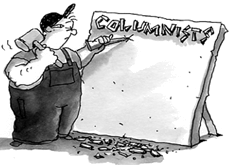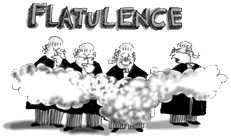Newman's poisoned legacy
 Stephen Keim SC & Alex McKean •
Stephen Keim SC & Alex McKean •  Wednesday, June 3, 2015
Wednesday, June 3, 2015 The Carmody catastrophe ... The damage to Queensland's Supreme Court wrought by the former premier and his attorney general ... Challenge to the concept of an independent judiciary ... Release of secret recording under Right to Information held up in the consultation phase ... Stephen Keim and Alex McKean review the landscape
 Newman and Bleijie: damaged Queensland's key institutions
Newman and Bleijie: damaged Queensland's key institutions
THE LNP has released the Borbidge-Sheldon report, the product of a review of the factors that led to its surprising electoral loss in January, this year. The report is being hailed by its authors as a fearless and frank appraisal of the failures of the Newman government.
However, many matters remain unaddressed.
While it does identify that the Newman government was arrogant and alienated stakeholders, it does not address what was central to many voters in rejecting outright a second LNP term.
This was the government's track record of attacking the independence of key institutions whose role it is to keep executive power in check and to protect the rights of the individual.
The legacy of the former attorney general, Jarrod Bleijie, working with his former premier, requires attention. Apart from Newman himself, Bleijie, more than any other, is associated in the public mind with a disregard for principles and a willingness to attack key independent institutions. It is these qualities that have so damaged the LNP.
The Borbidge-Sheldon report correctly identifies that the Newman government did not listen well or react positively, even to mild criticism. When the President of the Court of Appeal, Margaret McMurdo, gently, drew attention to the fact that the LNP government had appointed many more men than women to the bench, her words provoked an extremely hostile response from Bleijie, which included the selective use of confidential conversations with the president, herself.
However, one act of the Newman-Bleijie duumvirate continues to wreak havoc upon the Queensland justice system - the elevation of the then chief magistrate, Judge Tim Carmody, to the office of chief justice of Queensland.
Newman and Bleijie did not have to rely on suggestions that Judge Carmody did not have sufficient legal experience or deep enough legal knowledge to know that what they were doing was not in the interest of the state.
When chief magistrate Carmody made his new "new sheriff in town" speech, when refusing a number of bail applications, Bleijie might have been gratified for the political support from a leading judge for the attorney's new bikie laws. He should have been aware, however, that such partisanship on the part of a judicial officer was not to be encouraged.
The same mixture of warm pleasure and loud warning bells should have been present when chief magistrate Carmody came to Bleijie's defence in the wake of his attack on president McMurdo.
A third example of Judge Carmody's unsuitability for the office was his willingness to be part of the political campaign in support of his own appointment. Carmody agreed to attend the announcement press conference with premier Newman and forcibly proclaimed his own independence.
The pattern of Newman and Bleijie's encouragement of actions by Judge Carmody, which were positively unjudicial, was becoming set in stone. The evidence of recent weeks suggests that that pattern may run much deeper than the public was allowed to see.
Once he was appointed, Chief Justice Carmody had the opportunity to put his displays of partisanship behind him. As we have previously written, the chief justice might have put his head down, worked hard, and earned the respect even of his most grudging critics. Others had done it before him.
In doing so, the chief justice might have provided a lucky bounce for the legacy of Newman and Bleijie and, ironically, strengthened the institutions they had sought to weaken.
One sign that the chief justice was not turning his world around involved observations by journalists that he was scheduled to spend less time in court than other judges and had provided very few written judgments.
The retirement speech of Justice Alan Wilson in late March indicated that the destructive effect of appointing Judge Carmody went beyond just leaving the other judges shorthanded when it came to the day to day grind of judging.
Justice Wilson’s speech still provides informative reading. He makes specific allegations, but his general charge also raised serious concern. He said that it was the contrast between what the chief justice said in public and the reality of what was happening that was causing a loss of the court's morale, so significant as to cause even junior judges to consider stepping down.
 A proclamation of judicial independence
A proclamation of judicial independence
It was the inability of the judges to canvass these matters in public that had driven Wilson to speak.
Of the four matters raised by the retiring judge, that which was most concerning for the justice system was the allegation that the chief justice had, until other judges intervened, been engaged in interfering with a long standing protocol that decided, ahead of time, which judges would sit in the Court of Disputed Returns.
At the end of January 2015, an election was held and the result was on a knife edge. An application to the Court of Disputed Returns had been foreshadowed and the result of that case might decide the result of the election.
Particularly, in circumstances where the chief justice's appointment had been criticised for his apparent partisanship, common sense as well as a sense of integrity, would guide any new chief justice to place as much distance as possible between himself and the processes and decisions involved in appointing the judge to the Court of Disputed Returns.
But that was not the chief justice's preferred path.
Further evidence of the damage arose during the Brett Cowan appeals.
In responding to the possibility that a meeting with a social campaigner during the currency of the appeals may have raised an impression of bias, chief justice Carmody accused president McMurdo of attempting to improperly influence him and the lawyers acting for Cowan of seeking to profit by raising points on behalf of their client.
Of all the qualities that judges need, an ability to remain imperturbable in the face of criticism is one of the most important. Trials are places where ideas are floated and questioned and an attack on a judge's ideas must not be perceived by the judicial officer as a personal attack.
The events of the Cowan appeal, however, showed the chief justice displaying extreme personal sensitivity and striking back at his judicial colleagues and at the lawyers whose duty it was to raise all points available to their client.
In April, the chief justice foreshadowed that he might resign. Some interpreted this as no more than a strategic move in a campaign to outflank his critics.
Then, in an exclusive interview, published on May 25, he announced that he was prepared to resign at a price. He required compensation for giving up his salary, three years before he would be eligible for a judicial pension.
The chief justice referred to serious cultural and structural problems within the judiciary that had their origin and were festering long before his appointment. He accused his colleagues of being resistant to change and modernisation.
Carmody said that he was appointed to bring in needed reforms. Part of the chief justice's price for his resignation was that the government commit to an unspecified program of reforms. He had promised to outline the content of his reforms in a speech on May 29, but the speech was cancelled.
Apart from mention of a judicial commission (to assist in recommending judicial appointments and in dealing with complaints against judges) and a suggested program of televising the courts, there seems to be no indication that Carmody has proposed any reforms of the court system in the recent past. Neither of the two suggestions he has made has received any public resistance from his fellow judges.
His demand for a fair price for his resignation does, however, raise deeper questions about the damage being done by the appointment of Carmody as chief justice by Newman and Bleijie.
The CJ seemed to be attacking the heritage left by his predecessor, the current governor of Queensland, Paul de Jersey. Chief Justice de Jersey served in that role for over 16 years. He was a fine, hardworking jurist. He was highly respected as the public face of the courts. He was regarded as standing up for the courts as an institution against governments of all political colours without straying into the overtly political.
No one could have done more than the current governor to achieve Chief Justice Carmody's stated objective of creating a court system that the people of Queensland could respect and trust; a court system that was accountable for what was done not only through the court's judgments but through the conduct of the court's judges and how the courts treated other human beings.
Newman appeared to have recognised Chief Justice de Jersey's fine legacy by choosing him to head the executive and represent the Crown in Queensland.
By his political campaign for his own future, Carmody has launched an attack on the court system which forms so great a part of de Jersey's legacy.
Even more ominous is the chief justice's reference to the needed reforms he was appointed to bring in.
Was he appointed by Newman and Bleijie with an agenda of changes that they wanted made to the way the courts operated? If so, what were these changes? Did chief justice Carmody believe that changes to the protocol for appointment of judges to the Court of Disputed Returns was part of this agenda? Was his attack on the fellow members of the appeal bench and on the lawyers appearing for Cowan part of the grand vision?
The idea that a head of jurisdiction is appointed to bring in an agenda of reforms may yet be the most disturbing aspect of the Newman-Bleijie attack on the institutions of justice in Queensland. It challenges the whole concept of an independent judiciary.
In place of the cancelled reform speech, last Saturday another unsourced story appeared. This article portrayed a recorded conversation between the chief justice and two other justices of the court as a set-up by the other two judges.
At the same time, release pursuant to the Right to Information Act of that recording, and other documents going to the matters discussed by Alan Wilson, has been held up in the consultation phase by at least one judge who wishes to delay their release.
There is no prospect that chief justice Carmody's price for his resignation will be met by the executive.
The damaging legacy of Newman's and Bleijie's choice for chief justice may yet continue for some time.
Stephen Keim and Alex McKean










Reader Comments